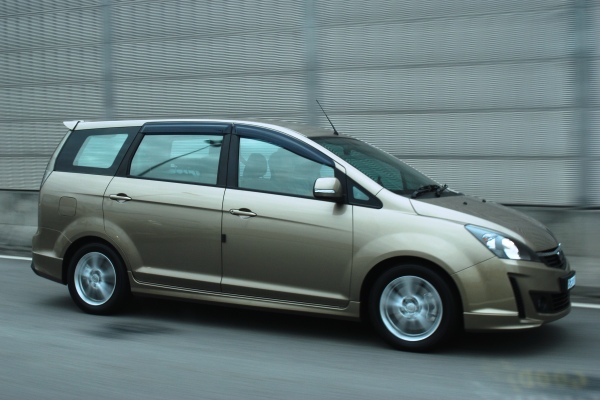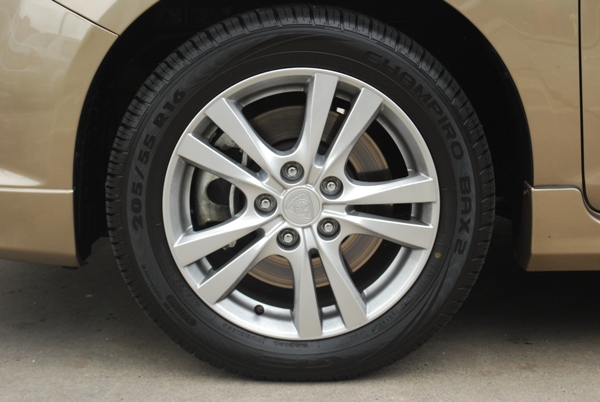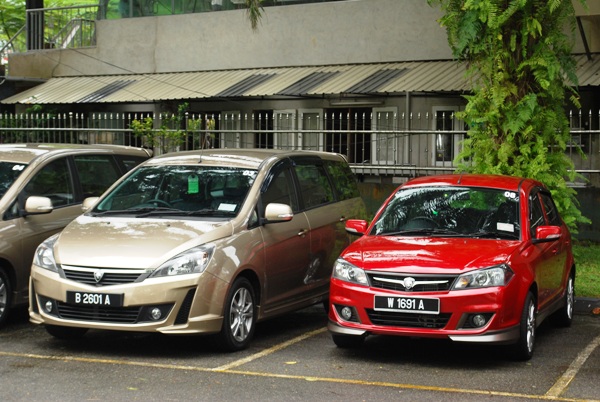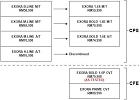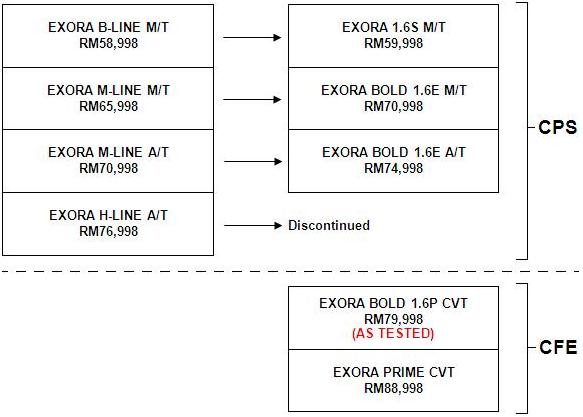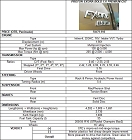Proton Exora Bold Premium 1.6 CFE – Campro Turbo debuts
Proton’s turbocharged Campro engine is finally here, and first recipient of the much-awaited engine is the Exora, which has been given a mild facelift to coincide with the new engine’s introduction. Official moniker for the engine is Charged Fuel Efficiency, and while it is not exactly in the same league as say, the BMW Prince or Ford EcoBoost engine, it is a good effort from Proton.
Developed with the original Campro non-CPS engine as a starting point, the CFE engine represents a big step forward in technology as far as Proton is concerned. It is the company’s first engine to feature turbocharging and, not counting the Inspira’s MIVEC system, intake variable valve timing. The CPS system is not featured.
 |
| New powertrain gives the Exora more sprightly performance. |
Prices & Variants
The new CFE engine’s arrival has yet to spell the end of the Campro CPS engine. Although not exactly a good match for the Exora’s heavy frame, the CPS gives Proton a means to offer more competitively priced variants for cost conscious buyers, and that is exactly what they have done.
Proton has reorganized the Exora’s range to five variants, starting from the standard 1.6 CPS model with manual transmission. Moving up, we have the Exora Bold, which consists of three variants – Executive M/T, Executive A/T, and Premium CVT. The Executive models are powered by the CPS engine, whilst the Premium model, as tested in this review, derives propulsion from the new CFE motor.
Topping the range is the Exora Prime, offered exclusively with the CFE engine and CVT. Prices span from RM59,998 with insurance in Peninsula Malaysia for the standard model to RM88,998 for the Prime model. Our Premium CVT test spec sits a step below at RM79,998.
 |
Campro CFE engine & CVT
The new CFE engine is built on the Campro’s original block, which has a 76.0mm cylinder bore. Resized pistons and con-rods, however, have resulted in its stroke shortened by 2mm to 86.0mm, giving a resultant displacement of 1,561cc, compared to the previous 1,597cc. Compression ratio has also been reduced from 10.0 in the naturally aspirated engines to 8.9.
Although not of the same calibre as aforementioned European alternatives, Proton’s maiden foray into turbocharging technology has brought about significant improvements in performance. Power output is now rated at 138hp @ 5,000rpm, but the headline news is that torque, a noted Achilles heel of the Campro, is now available in abundance with 205Nm usefully spread between 2,000 and 4,000rpm.
In the transmission department, Proton is in the midst of switching its transmission suppliers to Getrag for manuals and Punch for CVTs. While the CPS variants continue to use the venerable Mitsubishi-sourced gearboxes, the CFE engine is now being paired exclusively with CVT. Manual transmission is not offered with the engine for the time being.
It should be noted that the new Punch-sourced CVTs, which debuted in the Saga FLX, are different from the Inspira’s INVECS-III unit. Compared to the FLX’s transmission, Proton has specified a higher grade unit for the Exora to account for the CFE engine’s greater performance. There is a 12.5kW transmission oil cooler to keep fluid temperatures below a maximum of 120°C.
A feature that is unique to Proton’s application of CVTs is the Stepped Automatic Transmission (SAT) function that sees the transmission mimic the stepped gear shifting nature of torque converter transmissions. There are six pre-set ratios for the function, but like in the Saga FLX, manual overriding is not available. In situations where more aggressive ratios are called for, the driver is advised to move the selector lever to ‘L’.
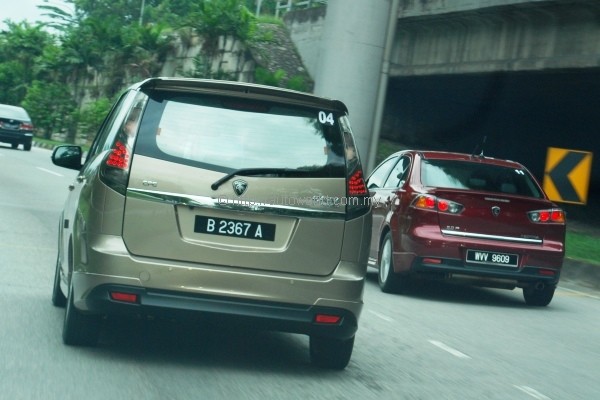 |
| Exora’s Punch CVT is different from the Inspira’s Jatco-sourced unit. Not as polished. |
Other Enhancements
Whilst the CPS models maintain more or less the same level of equipment as before, the CFE versions come with a bit more toys. Most significant enhancement is the use of four disc brakes, with rotors big enough to completely fill the new 16″ alloy rims wrapped by 205/55 GTRadial tyres. Side mirrors fold electrically, and there is now a reverse camera, with images projected on the rear view mirror.
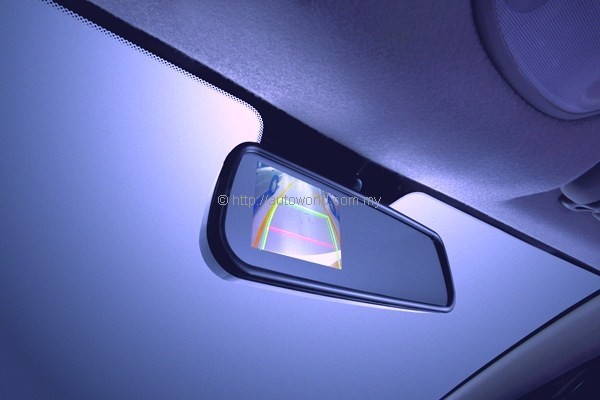 |
| Reverse camera monitor incorporated into rear view mirror |
In terms of appearance, the new Exora features the usual array of reworked bumpers and bodykits with smoked head and tail lamps thrown in for good measure. It is worth noting, however, that in the CFE variants at least, the new front bumper features an actual aerodynamic enhancement. The port side vertical slit is a functional one, routing air to the turbo’s intercooler.
 |
| Left side slit of new bumper supplies air to the turbo’s intercooler. |
Driving Experience
Even in its original form, the Exora has been noted for its above average driving dynamics that stand up to comparison against passenger cars, let alone MPVs. The new CFE versions maintain that competence, while adding respectable straight line performance to the mix as well.
Unlike the CPS versions which struggled with even the most moderate of slopes, the CFE’s fat mid-range allows the Exora to progress with a great deal more dignity and refinement. The old 4-speed auto’s trigger-happy kick down response has been toned down substantially as the engine now needs a lot less revs for brisk progress.
Speaking of transmissions, Proton’s still fledgling efforts in CVT technology are commendable, but lacking a little in polish. The SAT mode is a novel idea, but does not quite achieve its objective in simulating the feel of conventional transmission. It would have been better for Proton to just embrace the CVT’s stepless feel and make no apologies for it.
A couple of issues blighted our test car, which might have been a pre-production unit. The steering wheel was giving out substantial amount of vibrations, and was off-centre when going straight ahead – indicative of poor wheel alignment. Fortunately, body movements were controlled with competence, and overall high speed stability was good.
Verdict
Although some rough edges remain, think rough plastics and poor sound insulation, Proton’s enhancements to the Exora has made it a better developed product as a whole. The CFE engine addresses previous complaints of sluggish performance, and the CVT gives a more refined behaviour compared to the previous 4-speed auto.
The top spec Exora Prime at RM89k may seem a little excessive, but we find the Bold Premium spec as tested here to be a compelling offer being just a RM3k hike from the now-discontinued High Line model offering new engine, drivetrain, bigger brakes and more equipment.
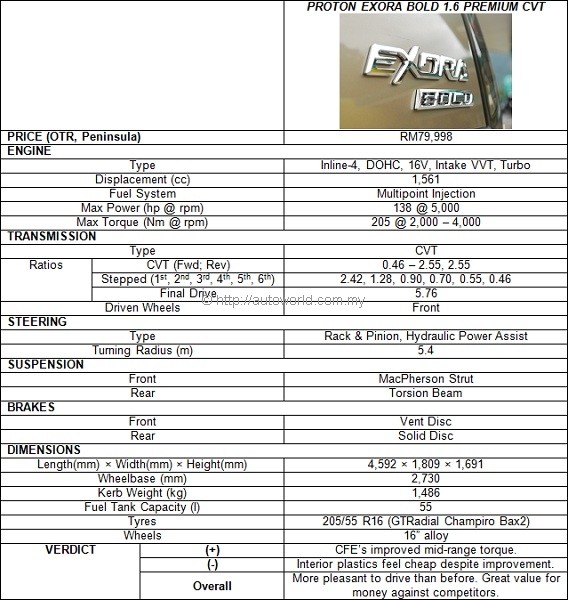 |
Pictures: KON & Official Proton release.









